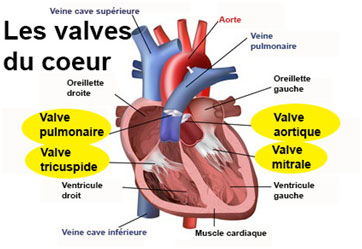Cardio-vascular illnesses
The Valvulopathies
 The valvulopathies are diseases of the cardiac valves: mainly of the mitral valve or the aortic valve.
The valvulopathies are diseases of the cardiac valves: mainly of the mitral valve or the aortic valve.
The mitral valve is the valve which is separating the left atrium from the left ventrium.
In countries of the Occident, around 2 % are affected by it, and this has a prevailing tendency of becoming more and more with age
(calculated for being between 10 to 15% for patients over the age of 75).
There are 2 types of a dysfunction of the cardiac valves :
- The stenosis (narrowing of the valve) :
The valve does not open sufficiently and the flux of blood is therefore slowed down.
- The insufficiency (leakage) :
The valve is not closing properly and heart has therefore to work more, so that it can function normally.
These dysfunctions bring along a dilation and a tired heart : being short of breath and the risk of oedemas of the inferior legs, uneasiness, sometimes lost of conscience, palpitations, congestive heart-failure.
What causes a valvulopathy ?
Valvulopathies can have several causes, namely, of the functioning of the valve, but principal ones are: being of degenerative origin, of an infection (infective endocarditis), from an inflammatory or bacterial disease, or coming of a functional origin.
What treatments are available ?
Prevention is strongly recommended, in order to foresee infectious endocarditis, as well as being checked-up regularly when the valvulopathy is yet not fully developed and doesn’t show symptoms or a slow-down of the heart..
When a valvulopathy is not yet fully developed, the following treatment :
- An interventional cardiology in the case of a valvular insufficiency,
in case the valve is not severely damaged.
A cardiac surgery: This is a reparative surgery, especially for mitral insufficiency or congenital origin, or a replacement of the valve
The replacement of a valve can be done with a mechanical or a biological prothesis.
If cone with a mechanical prothesis, anticoagulants will be needed for treatment and a regular surveillance of the coagulation.



